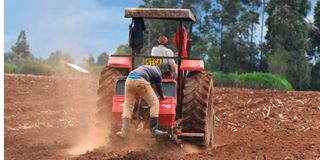North Rift counties project drop in yields over lack of fertiliser

Farmers planting maize at a farm in Kiplombe, Uasin Gishu County on April 28, 2022. Farmers who did not get the government’s subsidized planting fertiliser which was being sold at Sh2,800 per a 50kilograms bag were buying planting fertiliser from traders at Sh6,000 from traders.
A shortage of top-dressing fertiliser has been reported in the North Rift region, with counties projecting a decline in maize production that will threaten Kenya’s food security.
This planting season has been tough for most cereal growers in the region following an acute shortage of the fertiliser.
Most members of cooperatives are struggling to find the input from National Cereals and Produce Board (NCPB) stores.
Some of them say that despite booking dozens of bags, they had been unable to get the commodity, a situation that has persisted since the government announced it would provide subsidised fertiliser.
“We visited the stores last week and paid for the commodity but we were informed that we could get only 20 bags. Still, we can only get two or three bags, which will not be adequate for us,” said Peter Kibet, a farmer in Moiben, Uasin Gishu County.
“However, we are still waiting for it. It is better we wait because the commodity is expensive in the market,” he said.
Tedious process
He said the process is tedious because one must get verification from local agricultural offices and the chief’s office.
A tour of farms in the region considered Kenya’s main grain basket showed that maize plants had started shooting.
David Kipchumba, a maize farmer in Ziwa, Soy sub-county, Uasin Gishu, said he had to cut the acreage under the crop because of rising costs of fertiliser and other farm inputs.
Last season, he said, he planted 10 acres of maize but this year he reduced the land under the crop to four acres.
“I was forced to use one bag of DAP instead of two per acre due to high prices. I had hoped that I would add two bags, but I don’t know what I will do, because there is a shortage of the commodity,” he said, noting that he normally applies two bags UREA per acre.
Fertiliser prices
A 50kg bag of UREA goes for between Sh7,000 and Sh7,500, and with high fuel prices, the cost of production has risen. In the next month, farmers will also need CAN for their crop.
A 50kg bag of CAN now sells for Sh5,000, while DAP goes for Sh6,000 in the retail market.
“We don’t understand what the problem is. If things continue like this, we might realise low yields next year. Most farmers are also shifting to other crops such as coffee and passion fruit,” Mr Kipchumba said.
Projections
In Uasin Gishu, annual maize production this season is between four million and five million bags. Last year, farmers harvested 4.9 million bags, according to Agriculture executive Samuel Yego.
He said that the devolved unit was projecting a drop in production due to a shortage of fertiliser and the rising cost of this other farm inputs.
In Trans Nzoia, Agriculture executive Mary Nzomo said they were projecting a decline in yields of up to 30 per cent as farmers failed to get preferred crop and soil-specific fertilisers due to high costs and shortages.
“In fact, some farmers planted without fertiliser, while others used manure, which is a slow-release fertiliser. We encourage farmers to use foliar feed to help boost their crops,” Dr Nzomo said.
Top dressing
She observed that as farmers prepare for the top-dressing period, there is an anticipated shortage of commodity because ammonia, a key component in the fertiliser, is in short supply because countries like Turkey and Ukraine, which supply the raw material, are not exporting it.
“Top dressing is critical for the maize crop and under-usage of [it] will lead to low productivity and consequently lead to food insecurity,” she said.
Kipkorir Menjo, a Kenya Farmers Association official, said the sky-rocketing costs of farm inputs threaten Kenya’s food security.
With Turkey halting exports of the commodity, he said, this will further push up its cost.
“With the shortage, forces of demand and supply are likely to result in a rise in prices in the market. We urge the government to mop up the stocks of the top-dressing fertiliser in all stations and distribute them to areas where it is needed most,” Mr Menjo added.





